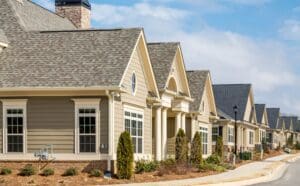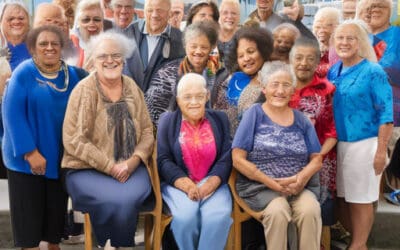Community Activities and Senior Health
For good reason, senior living communities near me have grown in popularity. These communities are more than simply a place to live; they offer a vibrant environment where elders can participate in activities that improve their health. Community activities in these environments enhance physical health, mental stimulation, social connections, and emotional satisfaction.

Senior well-being depends on physical health, which community activities help preserve and improve. Senior living communities often offer physical activities customized to members’ needs and abilities. Low-impact workouts like yoga, tai chi, and water aerobics increase flexibility, balance, and strength. Athletic activity helps elders manage chronic illnesses like arthritis and diabetes, retain mobility, and prevent falls. The planned nature of these activities encourages continuous involvement, maximizing physical health advantages for residents.
Mental stimulation from communal activities is crucial for cognitive health beyond the physical benefits. Puzzles, quizzes, and book clubs stimulate the brain. New hobbies like painting or music can excite the brain by building new neural connections. These activities slow cognitive deterioration and give a sense of purpose. Residents have many chances to stay alert at senior living homes, where activities are fun and educational.
Senior living community activities also foster social connections. Elderly loneliness and social isolation can cause melancholy and cognitive deterioration. Community activities assist folks to make and keep friends. Group outings, movie nights, and gardening clubs build community. Camaraderie from shared experiences improves elders’ emotional well-being and quality of life.
Activity variety and quality in senior living facilities affect emotional well-being. Enjoyable hobbies improve mood and minimize stress and anxiety. Art forms, including painting, ceramics, and music, can help you express yourself and release emotions. Mindfulness practices like meditation and guided visualization can help folks manage stress and find inner peace. A senior living community’s friendly environment and various activities assist people in coping with aging’s emotional concerns.
Community activities give people a meaningful sense of purpose. Many older adults feel purposeless after retiring or having their children move out. Volunteering, mentorship, and community service can restore purpose and self-worth. Senior living homes often offer organized volunteer initiatives that help others and reinforce members’ values.
Seniors can often find solace in organized activities’ structure and routine. A daily or weekly program helps maintain normalcy and predictability for persons with memory loss or cognitive impairment. The prospect of fun events might motivate seniors to stay active.
Senior living communities offer activities for all interests and abilities. These activities enrich residents’ lives via fitness, learning, socializing, and creativity. These events promote community and support, making all residents feel appreciated.
Additionally, community activities affect the entire community. When residents are active, the town feels more alive. Positive energy can boost the community’s appeal, attracting newcomers and keeping old ones. Community activities foster a supportive environment where residents help each other and participate in their successes and failures.
![]()
Green Senior Living Options
As demand for senior living communities near me rises, so does knowledge of environmentally sustainable living options. Seniors today care more about their environmental impact and want communities that respect sustainability and conservation. Popular eco-friendly senior living homes combine modern amenities with green living practices that promote a healthy earth and lifestyle.
Sustainable building materials are prioritized in these areas. Green building methods, including recycled and local materials, lessen new developments’ carbon footprint. Energy-efficient equipment and systems are standard in these areas, reducing energy use and greenhouse gas emissions. Solar panels, geothermal heating, and sophisticated insulation are used to reduce energy use and improve comfort.
Water conservation is another eco-friendly senior living requirement. Many cities adopt rainwater collection and drought-resistant landscaping to conserve water. Low-flow bathroom and kitchen fixtures also increase water savings. These methods improve the environment and lower utility costs, making eco-friendly living sustainable and affordable.
Green senior living homes generally recycle and compost in addition to water conservation and sustainable building. These programs urge households to recycle and reduce waste. Composting organic waste reduces landfill waste and enriches community garden soil. Eco-friendly communities frequently have gardens where members can grow fruits and vegetables, supporting a healthy, sustainable farm-to-table lifestyle.
Eco-friendly senior living complexes also improve transportation. Many of these towns are walkable, with essential services and amenities nearby, decreasing households’ car use and carbon footprint. Communities offer electric vehicle charging facilities and energy-efficient shuttle services for more extended travel. These transportation solutions help seniors live sustainably and stay connected.
Another critical component of eco-friendly senior living facilities is nature integration. Walking trails, community gardens, and green spaces are designed to improve the environment and allow citizens to connect with nature. The visual and recreational benefits of these green places help improve people’s health. Research shows that seniors need nature to relieve stress, enhance mood, and exercise.
Community engagement and education are essential to eco-friendly senior living. Many communities teach sustainable living through workshops and initiatives. Energy saving, organic gardening, and waste reduction are presented to help homeowners make eco-friendly decisions. As residents collaborate to build a sustainable future, these educational programs build community.
Living in an eco-friendly environment has significant social benefits. Residents feel connected by shared ideals and sustainability. Residents can engage and participate through social gatherings, volunteer opportunities, and collaborative initiatives like community gardens and clean-ups. These activities develop communal bonds and improve quality of life.
Sustainable senior living communities emphasize health and wellness. They typically advocate sustainable eating and lifestyle choices. Community eating facilities offer healthful, sustainable meals made from organic and locally sourced ingredients. Outdoor activities, yoga, and fitness programs keep residents active, improving their mental and physical health.

Technology is vital in eco-friendly senior living complexes. Smart homes include energy-efficient lighting, automated climate management, and water-saving systems to improve comfort and reduce resource use. These technologies make sustainable living more accessible and provide convenience and peace of mind. Community-wide solutions like solar-powered street lighting and energy-efficient heating and cooling show a more significant commitment to sustainability.
An eco-friendly senior living community represents a growing interest in sustainability and environmental responsibility. Today’s seniors are more aware and proactive, choosing communities that fit their needs and ideals. Eco-friendly senior living communities combine comfort, sustainability, and community, making them appealing to seniors who want to improve the environment while living well.
In conclusion, eco-friendly senior living communities near me offer a compelling vision of sustainable senior living. These communities provide holistic elder living that helps residents and the environment by incorporating green building, water conservation, waste reduction, sustainable transportation, and community engagement. Health, wellness, and technology make these communities appealing and a paradigm for future senior living initiatives.



